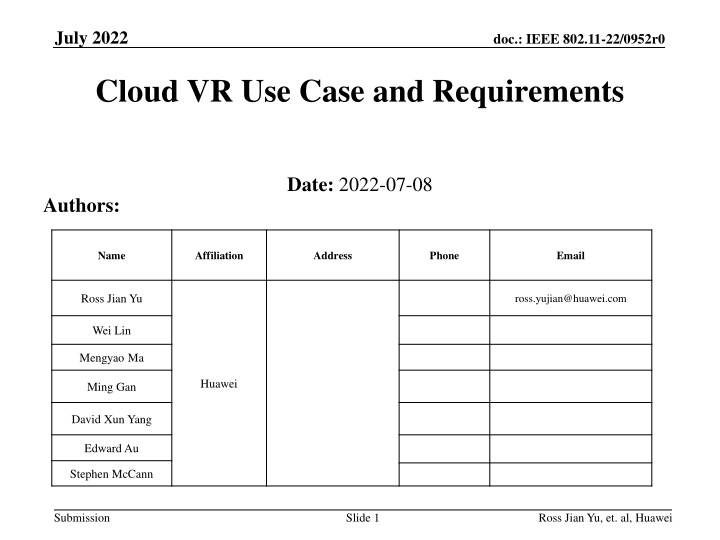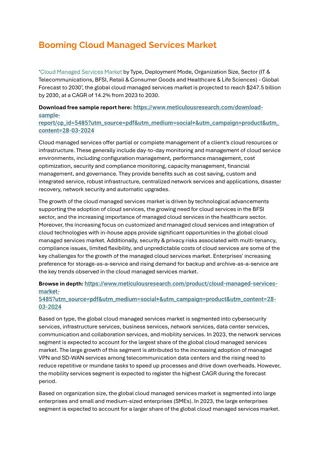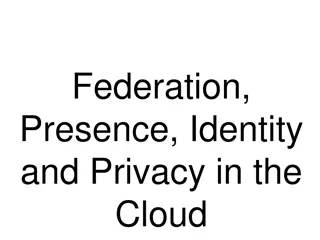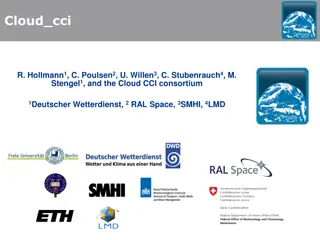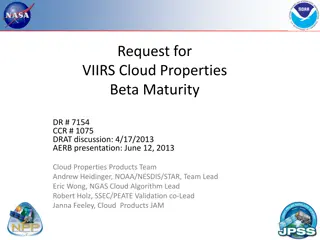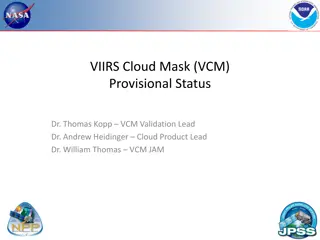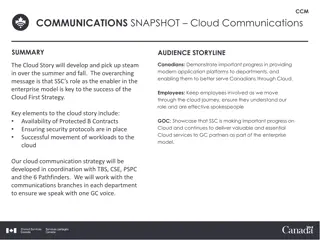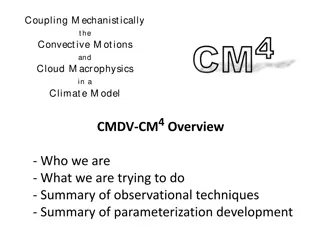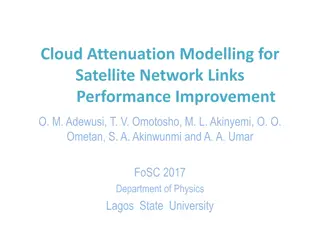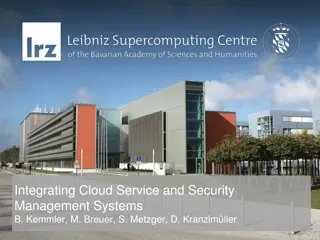Cloud VR Network Requirements and Development Strategy in July 2022
Cloud VR is a cutting-edge cloud computing technology for VR services, allowing for immersive, interactive, and imaginative experiences. The network requirements of Cloud VR involve factors like sense of reality, interaction, pleasure, resolution, frame rate, and more. The development strategy for Cloud VR focuses on three phases for enhancing user experience through network upgrades and evolution towards higher bandwidth and lower latency.
Download Presentation

Please find below an Image/Link to download the presentation.
The content on the website is provided AS IS for your information and personal use only. It may not be sold, licensed, or shared on other websites without obtaining consent from the author.If you encounter any issues during the download, it is possible that the publisher has removed the file from their server.
You are allowed to download the files provided on this website for personal or commercial use, subject to the condition that they are used lawfully. All files are the property of their respective owners.
The content on the website is provided AS IS for your information and personal use only. It may not be sold, licensed, or shared on other websites without obtaining consent from the author.
E N D
Presentation Transcript
July 2022 doc.: IEEE 802.11-22/0952r0 Cloud VR Use Case and Requirements Date: 2022-07-08 Authors: Name Affiliation Address Phone Email Ross Jian Yu ross.yujian@huawei.com Wei Lin Mengyao Ma Huawei Ming Gan David Xun Yang Edward Au Stephen McCann Submission Slide 1 Ross Jian Yu, et. al, Huawei
July 2022 doc.: IEEE 802.11-22/0952r0 Cloud VR Cloud VR is a new cloud computing technology for VR services. With fast and stable transport networks, VR content is stored and rendered in the cloud, and video and audio outputs are coded, compressed, and transmitted to user terminals [1]. Cloud VR B2C Application Scenario Cloud VR B2B Application Scenario Cloud VR IMAX Cloud VR education Cloud VR live broadcast Cloud VR eSports arena Cloud VR 360 video Cloud VR marketing Cloud VR gaming Cloud VR healthcare Cloud VR music Cloud VR tourism Cloud VR fitness Cloud VR real estate Cloud VR karaoke Cloud VR engineering Cloud social VR Cloud VR shopping Cloud VR service scenario overview Submission Slide 2 Ross Jian Yu, et. al, Huawei
July 2022 doc.: IEEE 802.11-22/0952r0 Network Requirements of Cloud VR Three characteristics and advantages of VR are immersion, interaction, and imagination (3I). Immersion: 3D images are generated by a computer to create a virtual environment that feels like the physical world. Interaction: People can use sensor devices to interact with each other in the virtual environments generated and feel like they are in the real world. Imagination: The virtual environment inspires the imagination of users. Accordingly, the experience evaluation factors of VR include sense of reality, interaction, and pleasure. [1] Sense of reality Sense of interaction Sense of pleasure Experience factor Resolution Frame rate FOV Color depth Coding & compression Initial buffer time Motion sensory conflict Operation latency Stalling (time and duration percentage) Artifacts (times and duration/area percentage) Effective frame rate in gaming Service indicator Network indicator Bandwidth Delay Packet loss Submission Slide 3 Ross Jian Yu, et. al, Huawei
July 2022 doc.: IEEE 802.11-22/0952r0 Cloud VR Network Development Strategy Before we look into details of the network requirements of cloud VR, let s divide the cloud VR development into three phases: Fair-experience phase: Home WLAN networks are added, and 4K-ready bearer network expansion and upgrade are performed. Comfortable-experience phase: Home WLAN and bearer networks are upgraded to guarantee bandwidth and latency. Ideal-experience phase: Networks are evolving towards higher bandwidth and lower latency Next we will discuss the cloud VR network requirement with regard to the three phases. Submission Slide 4 Ross Jian Yu, et. al, Huawei
July 2022 doc.: IEEE 802.11-22/0952r0 Deterministic Low Latency Required by Cloud VR For traditional 4K services, latency only slightly affects the channel switching time and loading duration. Therefore, the latency requirements for traditional 4K services are not demanding. However, the latency must be deterministic for strong-interaction VR services, because images are remotely rendered in the cloud. Otherwise, the screen refresh quality and user interaction are compromised. The following table provides recommended network latency levels for home WLAN, fixed access network, and metro network latency, according to the theoretical models and actual test results. Fixed Access Network [1] Phase E2E Network RTT Home WLAN Metro Network Fair-experience Phase 20 ms 10 ms 2 ms 8 ms Comfortable- experience Phase 15 ms 7 ms 2 ms 6 ms Ideal-experience Phase 8 ms 5 ms 2 ms 1 ms Submission Slide 5 Ross Jian Yu, et. al, Huawei
July 2022 doc.: IEEE 802.11-22/0952r0 Deterministic Low Latency Required by Cloud VR Recommended E2E latency planning for strong-interaction VR services: [1] Network Transmission Cloud processing Terminal processing Content/GPU engine cloud Asynchronous time wrapping, anti-distortion and light-up of the screen Bearer network Home-Wi-Fi Decoding & synchronization Procedure Logic computing Content rendering Coding, and data transmission Delay planning (Fair/comfortable/i deal-experience phase) 30 ms 25 ms 16 ms 20 ms 15 ms 8ms 20 ms 10 ms 6ms 20 ms Delay requirements (Fair/comfortable/i deal-experience phase) Cloud rendering and streaming delay: 70 ms 50 ms 30 ms MTP: 20 ms Submission Slide 6 Ross Jian Yu, et. al, Huawei
July 2022 doc.: IEEE 802.11-22/0952r0 Bandwidth Requirements of Cloud VR The immersive terminals of Cloud VR have a greater FOV than a traditional TV. To achieve the same definition as 4K video, the resolution, frame rate, and bitrate of Cloud VR must be higher than those of the 4K video services, posing higher bandwidth requirements on networks. According to the actual tests and theoretical analysis, Cloud VR has the following bandwidth requirements: [1] Comfortable- experience Phase of VR (8K Panorama) Ideal-experience Phase of VR (12K/24K Panorama) Fair-experience Phase of VR (4K Panorama) Network KPI 4K Video Bandwidth per service 50 Mbit/s 80 Mbit/s 260 Mbit/s 1 Gbit/s Submission Slide 7 Ross Jian Yu, et. al, Huawei
July 2022 doc.: IEEE 802.11-22/0952r0 Bandwidth Requirements of Cloud VR The estimated bandwidths required by VR video services in the three phases of Cloud VR development are as follows: [1] Phase Fair-experience Phase Comfortable-experience Phase Ideal-experience Phase 12K Typical full-view resolution 4K (3840*1920) 8K (7680*3840) (11520*5760)/24K(23040*1152 0) Typical terminal resolution 2K 4K 8K FOV 90 to 110 120 120 to 140 Color depth (bits) 8 8 10~12 Coding standard H.264/265 H.265 H.265/266 Frame rate 30 30 60~120 Compression ratio 133 230 410(12K), 1050(24K) Full-view: 290 Mbit/s (12K) 1090 Mbit/s(24K) FOV: 155 Mbit/s (12K) 580 Mbit/s(24K) Full-view: 90 Mbit/s FOV: 50 Mbit/s Typical bitrate 40 Mbit/s VR video service Full-view: 440 Mbit/s (12K) 1.6 Gbit/s(24K) FOV: 230 Mbit/s (12K) 870 Mbit/s(24K) Typical bandwidth requirement Full-view: 140 Mbit/s FOV: 75 Mbit/s 60 Mbit/s Submission Slide 8 Ross Jian Yu, et. al, Huawei
July 2022 doc.: IEEE 802.11-22/0952r0 Bandwidth Requirements of Cloud VR The estimated per-user bandwidths required by strong-interaction services in the three phases of Cloud VR development are as follows: [1] Phase Fair-experience Phase Comfortable-experience Phase Ideal-experience Phase 2K (equivalent full-view resolution: 4K) 4K (equivalent full-view resolution: 8K) 8K/16K (equivalent full-view resolution: 12K/24K) Typical content resolution Typical terminal resolution 2K 4K 8K/16K FOV 90 to 110 120 120 to 140 Color depth (bits) 8 8 10~12 Coding standard H.264/265 H.265 H.265/266 Compression ratio (I-frame/P- frame) 25/75 38/165 50/255(8K), 83/585 (16K) Full-view: 290 Mbit/s (12K) 1090 Mbit/s(24K) FOV: 155 Mbit/s (12K) 580 Mbit/s(24K) Typical bitrate 40 Mbit/s 90 Mbit/s Strong- interaction VR service Typical bandwidth requirement 360 Mbit/s (8K) 1.5 Gbit/s (16K) 80 Mbit/s 260 Mbit/s Submission Slide 9 Ross Jian Yu, et. al, Huawei
July 2022 doc.: IEEE 802.11-22/0952r0 Packet Loss Requirements of Cloud VR The packet loss rate requirements of video on demand (VoD) services can be calculated as follows under given RTT and bandwidth: [1] Comfortable-experience Phase Phase Fair-experience Phase Ideal-experience Phase RTT 20ms 20ms 20ms Bandwidth 60 Mbit/s 140 Mbit/s 440 Mbit/s Packet loss rate 9e-5 1.7e-5 1.7e-6 For strong interaction and live video services, the recommended packet loss requirements are as follows: Comfortable-experience Phase Phase Fair-experience Phase Ideal-experience Phase Packet loss rate 1e-5 1e-5 1e-6 Submission Slide 10 Ross Jian Yu, et. al, Huawei
July 2022 doc.: IEEE 802.11-22/0952r0 Network KPI Requirements Summary [1] Phase Fair-experience Phase Comfortable-experience Phase Ideal-experience Phase Video full-view resolution 4K to 8K 8K to 12K 12K to 24K Strong-interaction content resolution 2K to 4K 4K to 8K 8K to 16K FOV 90 to 110 120 120 to 140 Color depth (bits) 8 8 10~12 Coding standard H.264/265 H.265 H.265/266 30 (video services) 50-90 (strong interaction services) 30 (video services) 90 (strong interaction services) 60-120 (video services) 120-200 (strong interaction services) Frame rate (FPS) Full-view: 290 Mbit/s (12K) 1090 Mbit/s(24K) FOV: 155 Mbit/s (12K) 580 Mbit/s(24K) Full-view: 90 Mbit/s FOV: 50 Mbit/s bitrate 40 Mbit/s (4K) Full-view: 440 Mbit/s (12K) 1.6 Gbit/s(24K) FOV: 230 Mbit/s (12K) 870 Mbit/s(24K) Bandwidth requirement Full-view: 140 Mbit/s FOV: 75 Mbit/s 60 Mbit/s (4K) VR video service Recommended RTT level 20ms 20ms 20ms Packet loss requirement 9e-5 1.7e-5 1.7e-6 360 Mbit/s (8K) 440 Mbit/s(16K) bitrate 40 Mbit/s 90 Mbit/s Bandwidth requirement 1 Gbit/s (8K) 1.5 Gbit/s(16K) 80 Mbit/s 260 Mbit/s Strong-interaction VR service Recommended RTT level 20ms 15ms 8ms Packet loss requirement 1e-5 1e-5 1e-6 Submission Slide 11 Ross Jian Yu, et. al, Huawei
July 2022 doc.: IEEE 802.11-22/0952r0 Some enablers for Cloud VR Requirements Retransmission heavily prolongs packet transmission latency. If the latency exceeds the device tolerance or the number of retransmission attempts exceeds the threshold, packet loss occurs. When the actual channel condition is worse than the chosen code rates, the receiver can easily fail to decode the channel codeword, leading to a failure in source decoder and significant reduction in reconstructed video/image quality. Retransmission occupies the airtime, and thus also reduces the throughput/bandwidth of the cloud VR services. Some enablers are needed to reduce the latency. Submission Slide 12 Ross Jian Yu, et. al, Huawei
July 2022 doc.: IEEE 802.11-22/0952r0 QoS enhancement Enable different QoS for different frame types (I/P frame) or different modalities (video, audio, emotion data, haptic data, sensor data etc.). There are many works in 3GPP regarding how to standardize XR support since 2016 [2]. Service and System Aspect (SA) working group (WG) on Services (SA WG1 or SA1) specified 5G service requirements for high-rate and low-latency XR applications [3]. SA4 ( Multimedia Codecs, Systems and Services ) documented relevant traffic characteristics in [4] and provided a survey of XR applications in [5]. SA2 ( System Architecture and Services ) standardized new 5G quality of service identifiers (5QI) to support interactive services including XR [6]. RAN1 performed a R17 study on evaluating NR performance for the XR [7]. The normative work now continues in both SA and RAN for Release 18 (first 5G- Advanced release, tentatively, until 2023) [11,12]. There are also related papers discussing how to improve XR/Video over WLAN [9, 10] XR/Video awareness WLAN Higher QoS can enable lower latency for more important (e.g., base layer) services. Slide 13 Submission Ross Jian Yu, et. al, Huawei
July 2022 doc.: IEEE 802.11-22/0952r0 Unequal error protection (UEP) In [13], multi-layer transmission under improved link adaptation is mentioned as a feature that can be considered for next generation. Multi-layer transmission is one kind of unequal error protection at PHY layer that can provide different robustness to different services. The base layer is protected better with lower rate/MCS whilst the enhancement layer is protected with higher rate/MCS. May further do joint source and channel coding (JSCC) at PHY. UEP can achieve a good tradeoff between data rate and robustness. It can further reduce transmission latency. Submission Slide 14 Ross Jian Yu, et. al, Huawei
July 2022 doc.: IEEE 802.11-22/0952r0 Summary Cloud VR use cases and its requirements are introduced for three different phases. Latency Bandwidth Packet loss Some enablers for the cloud VR are briefly discussed. QoS enhancement Unequal error protection The details need to be further discussed within the Study group period. Submission Slide 15 Ross Jian Yu, et. al, Huawei
July 2022 doc.: IEEE 802.11-22/0952r0 Reference [1] Cloud VR network solution white paper, iLab, Huawei, https://www.huawei.com/minisite/pdf/ilab/cloud_vr_network_solution_wh ite_paper_en.pdf [2] Extended Reality (XR) over 5G and 5G-Advanced NewRadio: Standardization, Applications, and Trends, Vitaly Petrov et. al. [3] 3GPP, TS 22.261 Service requirements for the 5G system, v.18.5.0, Dec. 2021. [4] 3GPP, TR 26.925 Typical traffic characteristics of media services on 3GPP networks, v.17.0.0, Sept. 2021. [5] 3GPP, TR 26.928 Extended Reality (XR) in 5G, v.16.1.0, Dec. 2020. [6] 3GPP, TS 23.501 System architecture for the 5G System (5GS) , v.17.3.0, Dec. 2021. [7] 3GPP, TR 38.838 Study on XR (Extended Reality) evaluations for NR , v.17.0.0, Jan. 2022. [8] 11-22-0638-01-00be-consideration-on-the-tsn-capabilities-and-xr- applications-in-wi-fi Slide 16 Submission Ross Jian Yu, et. al, Huawei
July 2022 doc.: IEEE 802.11-22/0952r0 Reference (cont d) [9] Toward an improvement of H.264 video transmission over IEEE 802.11e through a cross layer architecture [10] Video over IEEE802.11 Wireless LAN: A Brief Survey [11] SP-211610 New SID on Study on architecture enhancement for XR and media services [12] RP-213587 XR Enhancements for NR [13] 11-22/0734r0 [14] 11-22/0030r1 Submission Slide 17 Ross Jian Yu, et. al, Huawei
